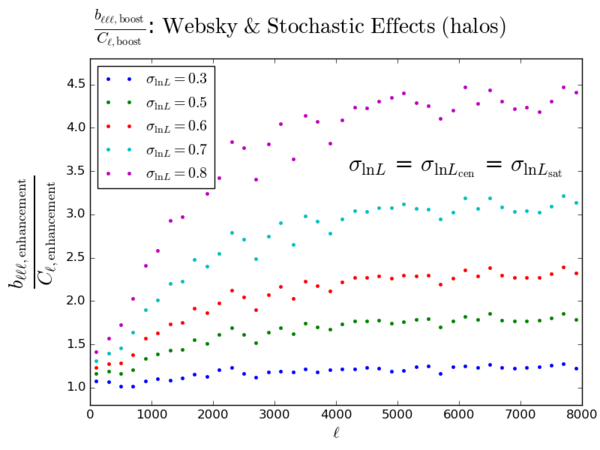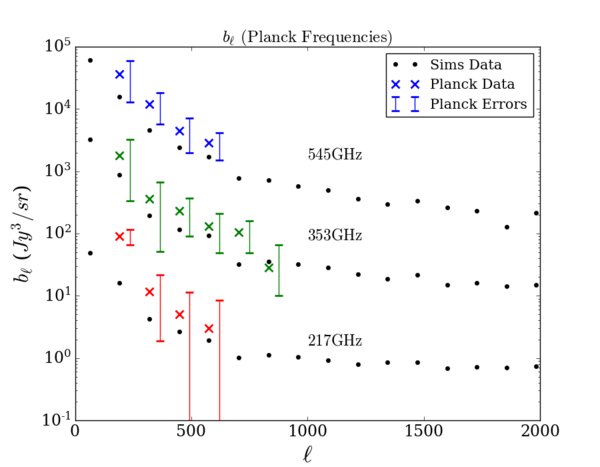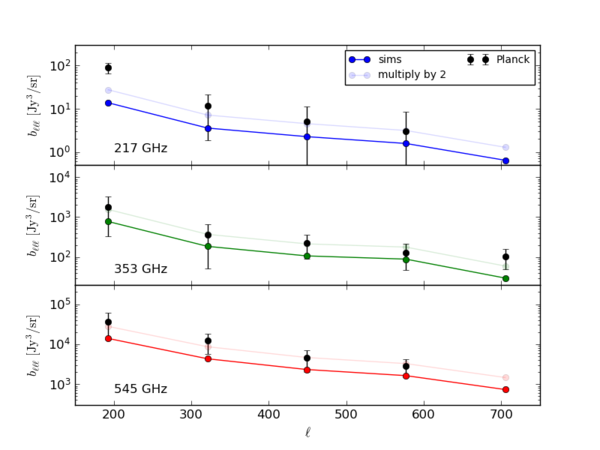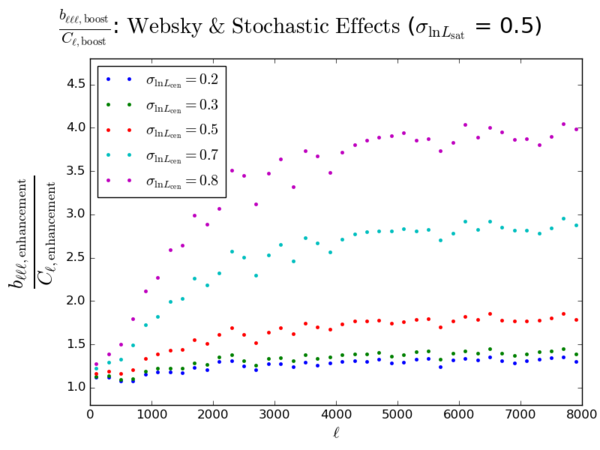Feb 27th, 2020 - Exploring the Stochasticity of Websky CIB Maps - II: Enhancement of the 3-Point Compared to the 2-point
Jump to navigation
Jump to search
This post is in complement to the recent post - https://mocks.cita.utoronto.ca/index.php/Feb_24th,_2020_-_Exploring_the_Stochasticity_of_Websky_CIB_Maps_-_II:_Halo_%26_Galaxy_Levels . Upon Pavel's suggestion, I have plotted the ratio of the enhancements of the reduced bispectra and the power spectra, again in the following three cases as before, plus the Planck vs. Websky [math]\displaystyle{ b_{\ell\ell\ell} }[/math] for a reference: 1. variation of [math]\displaystyle{ \sigma_{\ln L} = \sigma_{\ln L_{\text{cen}}} = \sigma_{\ln L_{\text{sat}}} }[/math] 2. [math]\displaystyle{ \sigma_{\ln L_{\text{cen}}} = 0.5 }[/math], variation of [math]\displaystyle{ \sigma_{\ln L_{\text{sat}}} }[/math] 3. [math]\displaystyle{ \sigma_{\ln L_{\text{sat}}} = 0.5 }[/math], variation of [math]\displaystyle{ \sigma_{\ln L_{\text{cen}}} }[/math]
Case 1: [math]\displaystyle{ \sigma_{\ln L} = \sigma_{\ln L_{\text{cen}}} = \sigma_{\ln L_{\text{sat}}} = (0.3, 0.5, 0.6, 0.7, 0.8) }[/math] and Planck vs. Websky [math]\displaystyle{ b_{\ell\ell\ell} }[/math]
The enhancement of the bispectra compared to the power spectra rapidly rises up until [math]\displaystyle{ \ell \approx 2000 }[/math], where it plateaus. While the ratios at high [math]\displaystyle{ \ell }[/math] are between 1.2 and 4.5 depending on [math]\displaystyle{ \sigma_{\ln L} }[/math], they are mostly lower than 2 at low [math]\displaystyle{ \ell }[/math]; in the right figure, we see that Planck values concern low [math]\displaystyle{ \ell }[/math] only. Consequently, the stochastic effects I have induced may not be enough to account solely for the factor of 2 discrepancy, given that the ratio I have plotted on the left will be the amount [math]\displaystyle{ b_{\ell\ell\ell} }[/math] is enhanced if the power spectra is calibrated to match Planck values. Furthermore, we see from the plot below in Pavel's previous post (https://mocks.cita.utoronto.ca/index.php/Nov_4,_2019_-_Looking_at_factor_3_in_bispectra),
that the Websky bispectrum is more than 2 times smaller at the lowest [math]\displaystyle{ \ell }[/math], while it is less than 2 times smaller at [math]\displaystyle{ \ell = 576 }[/math], which means that the trend is opposite compared to the ratios of the bispectra and power spectra enhancements (on the top left; this ratio increases with higher [math]\displaystyle{ \ell }[/math]). This may be different for lower [math]\displaystyle{ \sigma_{\ln L} }[/math] (where the ratios seem pretty constant at low [math]\displaystyle{ \ell }[/math]).
Case 2: [math]\displaystyle{ \sigma_{\ln L_{\text{cen}}} = 0.5 }[/math], [math]\displaystyle{ \sigma_{\ln L_{\text{sat}}} = (0.2, 0.3, 0.5, 0.7, 0.8) }[/math]
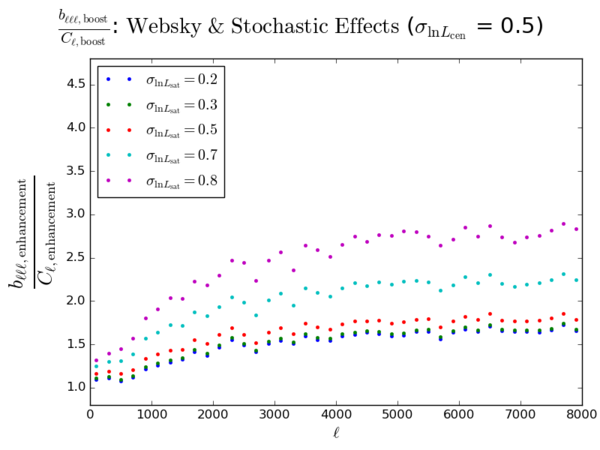
Again, we see here that the ratios change substantially depending on [math]\displaystyle{ \sigma_{\ln L_{\text{sat}}} }[/math].
Case 3: [math]\displaystyle{ \sigma_{\ln L_{\text{sat}}} = 0.5 }[/math], [math]\displaystyle{ \sigma_{\ln L_{\text{cen}}} = (0.2, 0.3, 0.5, 0.7, 0.8) }[/math]
Conclusion At first glance, it seems that the stochastic effects I have induced so far are not enough to account for the discrepancy between the Planck/Websky bispectrum at 545GHz; as Professor Bond mentioned before, it may be necessary to increase [math]\displaystyle{ \sigma_{\ln L} }[/math] closer to 1. Another thing to do could be to keep [math]\displaystyle{ \sigma_{\ln L} }[/math] low (under 0.5) and see what the combination of stochastic effects at [math]\displaystyle{ \sigma_{\ln L} \lt 0.5 }[/math] and the weak lensing gives us. It may also be necessary to do this for other frequencies with bins that exactly match Planck's.
